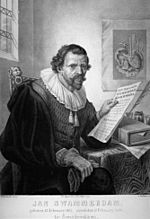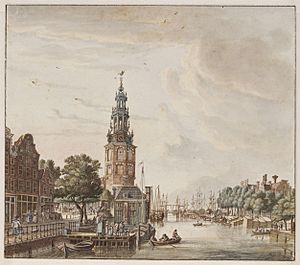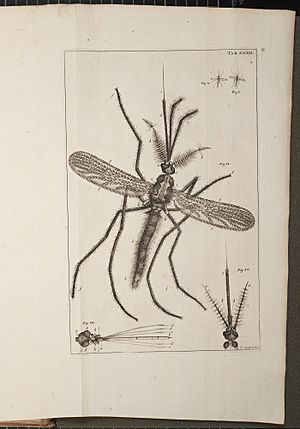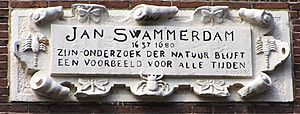Jan Swammerdam facts for kids
Quick facts for kids
Jan Swammerdam
|
|
|---|---|

A 19th century fantasy portrait: no genuine portrait of Jan Swammerdam is known.
|
|
| Born | 12 February 1637 |
| Died | 17 February 1680 (aged 43) Amsterdam, Dutch Republic
|
| Nationality | Dutch |
| Alma mater | University of Leiden |
| Known for | Describing erythrocytes, work on entomology |
| Scientific career | |
| Fields | Entomology |
Jan Swammerdam (born February 12, 1637 – died February 17, 1680) was a Dutch biologist. He was also a master at using the microscope.
Swammerdam studied insects very closely. He showed that an insect's life stages – egg, larva, pupa, and adult – are all parts of the same animal. He also did important experiments on how muscles contract. In 1658, he was the first person to see and describe red blood cells. He was one of the first scientists to use a microscope during dissections. His special techniques were used for hundreds of years.
Contents
Becoming a Scientist: Jan Swammerdam's Education
Jan Swammerdam was born in Amsterdam. His father was an apothecary, which is like a pharmacist. His father also collected many interesting things. These included minerals, old coins, fossils, and insects from all over the world.
As a young boy, Jan helped his father with this amazing collection. His father wanted him to study theology, which is the study of religion. But Jan chose to study medicine instead. He started at the University of Leiden in 1661.
While studying medicine, Jan began his own collection of insects. He also traveled to France to continue his studies. In 1665, he returned to the Dutch Republic. He joined a group of doctors who performed dissections and shared what they learned. In 1667, he finished his medical studies. He wrote about how we breathe, which was his final project.
Discovering Insect Life Cycles
In the 17th century, people's understanding of insects came mostly from ancient ideas. Swammerdam changed this. He carefully dissected insects and looked at them under his microscopes.
Swammerdam proved that insects grow and change gradually, just like other animals. He wanted to correct the old idea that different stages of an insect, like a caterpillar and a butterfly, were completely different creatures.
He found strong evidence by dissecting insect larvae. He saw adult features already forming inside the younger insects. For example, he noticed that the wings of dragonflies and mayflies were present before their final molt.
Swammerdam shared these discoveries in his 1669 book, Historia Insectorum Generalis. This book had many detailed descriptions of insect bodies. Later, in 1737, his book Biblia natura was published. It was the first to confirm that the queen bee is the only mother of a bee colony.
Jan Swammerdam's Lasting Impact
Jan Swammerdam and his father collected thousands of objects. Swammerdam's book on insects was very famous even before he died. It was translated into French and Latin soon after his death.
Many scientists praised Swammerdam's methods. He was known for his amazing skill with microscopes and his discoveries. He created new ways to study, preserve, and dissect specimens. For example, he injected wax into blood vessels to make them easier to see. He also invented a method to prepare hollow human organs for study.
Swammerdam shared his research with other scientists across Europe. His work helped others understand the natural world better. Today, Swammerdam is remembered for his important discoveries and his advanced techniques using the microscope.
There is no real portrait of Jan Swammerdam that we know of today. The picture at the top of this article is a fantasy portrait from the 19th century.
Images for kids
-
Swammerdam's illustration of a nerve-muscle preparation. He placed a frog thigh muscle in a glass syringe with a nerve protruding from a hole in the side of the container. Irritating the nerve caused the muscle to contract, but the level of the water, and thus the volume of the muscle, did not increase.
See also
 In Spanish: Jan Swammerdam para niños
In Spanish: Jan Swammerdam para niños








